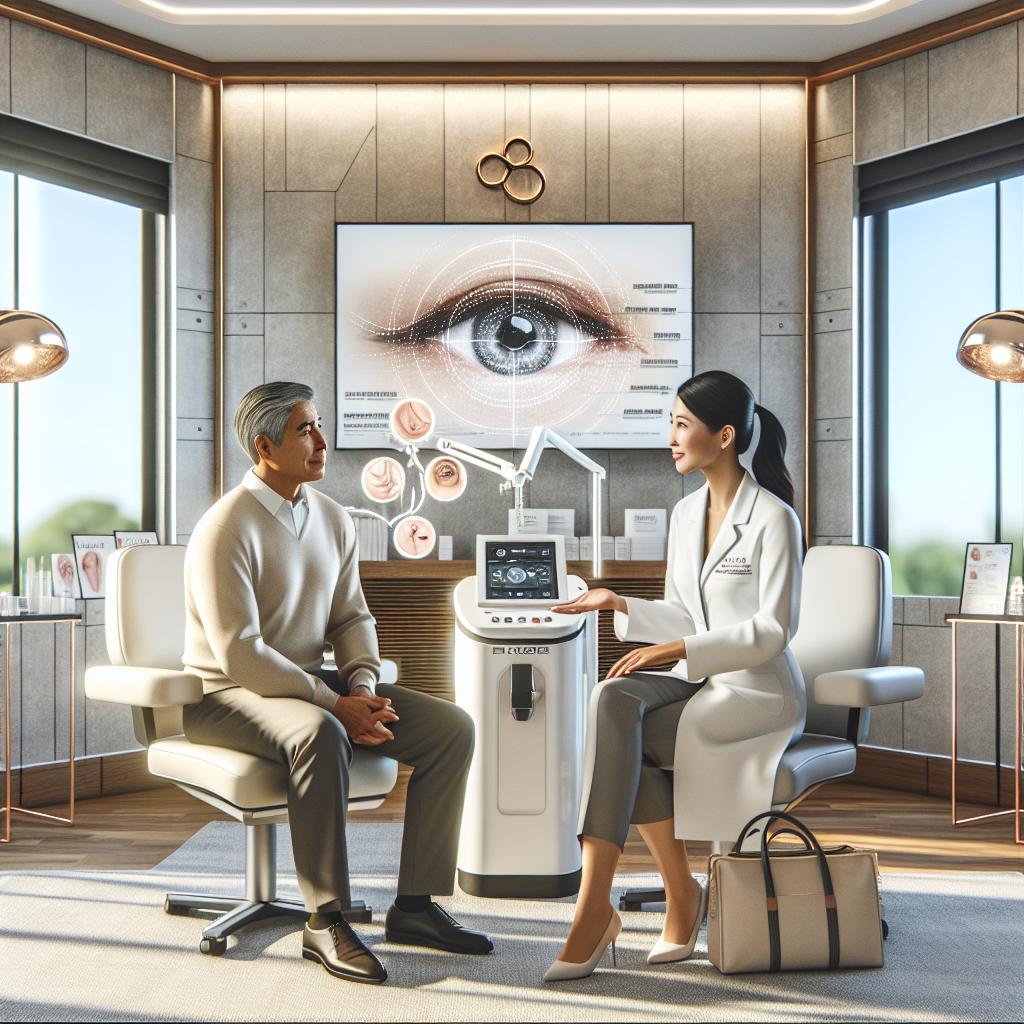Highlights
- Laser eye bag removal offers minimally invasive options that enhance appearance with minimal scarring and downtime.
- Non-surgical treatments like fractional CO2 laser and radiofrequency microneedling provide effective alternatives for mild to moderate cases.
- Ongoing advancements in laser technology are setting new standards for personalized and safe eye rejuvenation procedures.

Summary
Eye bags, caused by fat protrusion and skin laxity under the eyes, are a common sign of aging and fatigue. Laser eye bag removal has become a popular minimally invasive method offering surgical and non-surgical options to reduce puffiness and rejuvenate the under-eye area. Techniques like laser blepharoplasty remove or reposition fat via internal incisions, minimizing scarring and downtime. Non-surgical treatments, including fractional CO2 and Erbium lasers, radiofrequency microneedling (e.g., Agnes RF), and pico lasers, focus on skin tightening and pigmentation correction. These laser methods provide precision, reduced bleeding, and faster recovery but require careful patient selection. Advances in technology and combined therapies are enhancing personalized, effective treatments for eye bags.
Anatomy, Causes, and Clinical Presentation of Eye Bags
Eye bags result from the pseudo-herniation of infra-orbital fat pushing through a weakened orbital septum, combined with skin laxity and changes in facial structures. Puffiness can stem from fat protrusion or fluid retention (malar pocket). Age-related tissue and bone changes deepen under-eye hollows and create uneven contours. Genetics, aging, poor sleep, high salt intake, and sun exposure exacerbate puffiness. Skin thinning and reduced elasticity contribute to wrinkles, making skin rejuvenation important alongside fat reduction.
Eye Bag Removal Methods
Lower eyelid blepharoplasty is the most definitive surgical treatment, removing or repositioning fat and excess skin but requires recovery and carries risks like scarring. Laser blepharoplasty uses laser incisions internally to reduce bleeding, scarring, and recovery time while preserving natural eye contours. Non-surgical options such as Agnes RF radiofrequency microneedling and fractional lasers tighten skin and stimulate collagen with minimal discomfort and downtime, suitable for mild to moderate cases. Combined therapies, including platelet-rich plasma (PRP), enhance skin tone and elasticity. Maintenance treatments may be needed to sustain results.
Laser Technologies in Eye Bag Removal
Fractional CO2 and Erbium lasers precisely resurface damaged skin, improving texture and pigmentation with minimal downtime. Endolift laser increases skin thickness and elasticity, showing significant improvement in eye bags. Radiofrequency devices like Agnes RF deliver energy via microneedles to melt fat and tighten skin. Pico lasers target pigmentation and rejuvenate skin with ultra-short pulses and no downtime. Each technology is selected based on patient needs and skin type to maximize safety and efficacy.
Laser Eye Bag Removal Procedures and Safety
Laser blepharoplasty employs a transconjunctival laser incision to remove fat pads without external scars, preserving anatomy and providing natural results with minimal bleeding and downtime. Non-surgical laser and energy treatments complement fat reduction by improving skin texture and pigmentation. Procedures are generally safe when performed by experienced practitioners using certified equipment. Contraindications include active skin infections, recent sun exposure, pregnancy, and caution with darker skin types to prevent pigmentation issues. Patients experience mild, temporary redness post-treatment.
Clinical Benefits and Risks
Laser eye bag removal offers precise, minimally invasive fat removal with faster recovery and less scarring than traditional surgery. Concurrent laser resurfacing improves skin texture, reducing wrinkles and pigmentation for a youthful appearance. Non-surgical options provide fat reduction and skin tightening without incisions, with minimal discomfort and downtime. Risks include temporary swelling, redness, and pigmentation changes, especially in darker skin types. Proper patient selection and technique are essential to minimize complications.
Comparison of Surgical and Non-Surgical Methods
Surgical blepharoplasty provides more dramatic, long-lasting results for significant fat and skin excess but involves longer recovery and higher risks. Laser blepharoplasty offers a less invasive surgical alternative with faster healing. Non-surgical treatments like radiofrequency microneedling and pico lasers deliver subtle improvements with minimal downtime, ideal for mild to moderate cases. Hybrid approaches combining multiple technologies optimize outcomes and reduce side effects. Treatment choice depends on severity, anatomy, skin type, and patient preferences.
Technological Advances and Future Trends
By 2025, advancements in fractional CO2, Erbium lasers, radiofrequency microneedling, and hybrid systems have improved precision and patient outcomes in eye bag removal. Articulated laser systems and refined techniques enable detailed corrections with reduced tissue damage. Vision correction advances like Relex SMILE demonstrate progress in minimally invasive laser procedures. Emerging trends focus on integrating regenerative therapies (e.g., PRP) with laser and RF treatments to enhance skin elasticity and rejuvenation. Safety protocols and device standards continue to evolve, ensuring effective, personalized treatments will further improve by 2030.
Patient Experiences and Outcomes
Patients report natural-looking results from laser eye bag removal, with minimal visible scarring or altered eyelid anatomy. Treatments typically provide several months of rejuvenation, with maintenance sometimes required. The procedure’s minimal invasiveness and favorable recovery contribute to high satisfaction. Realistic expectations and personalized treatment plans are essential, as outcomes vary by individual anatomy, skin type, and lifestyle.
The content is provided by Sierra Knightley, Fact-Nest












